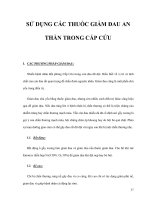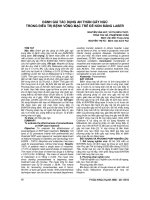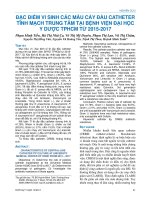GIẢM ĐAU , AN THẦN , GÂY TÊ TRONG HỒI SỨC NHI, Đ H Y DƯỢC TP HCM
Bạn đang xem bản rút gọn của tài liệu. Xem và tải ngay bản đầy đủ của tài liệu tại đây (501.04 KB, 34 trang )
ALNALGESIA, SEDATION AND
PARALYSIS
Definition
- Depression of Conscious level by drugs to immobilize, reliev pain,
anxioslysis
Sedation: Current Issues
Without a means to
objectively titrate
the level of sedation,
patients may be:
Over-sedated
Under-sedated
• increased drug costs
• delayed weaning
• increased ICU length of stay
• increased testing
• anxiety and agitation
• awareness and recall
• post-traumatic stress disorder
• increased adverse events
• increased use of paralytics
Incidence of Inappropriate Sedation
Olson D. et al.
2003
Kaplan L. and Bailey H.
2000
15.4%
20%
10%
30.6%
54%
70%
Over-sedation
On Target
Under-sedation
Kaplan L and Bailey H. Critical Care. 2000; 4(1):S110.
Olson D et al. NTI Proceedings. 2003; CS82:196.
DEFINITIONS
- Step 1: tissue damage
Madiators
Tissue products
• Prostaglandins
• P
• Bradykinin
• Histamin
• Serotonin
• Cytokines
• Acetaminophen, ibu
- Step 2: transduction
- Local anesthetics: lidocain
stop this step by inhibiting
Nainflux and pain signal
transduction.
- Step 3: transmission
- Release of neurotranmitters
(Subtance p NE glutamate)
to transmite pain signal.
Opiate:
sub p
inhibit release
Ketamine:
glutamate
Alpha
block:
release of NE.
bloc
inhibit
- Increase
inhibitory
neurotransmitters:
BZD,
Barbiturate increase GABA
- Step 4: perception
INDICATION FOR ANALGESIA AND
SEDATION
- Facilitate of MV
- Post of operation pain
- Invasive iatrogenic pain
- Trauma
- Agitation/anxiety
- Increased ICP
- imaging
Strategies
- Consider intermitter (q2-3) sedation (lorazepam) and analgesia
(morphin)
- Continuous anagelsia infusion (fentanyl) with intermittent sedation
(lorazepam).
- Escalate tocontinuous analgesia (fentanyl) and sedation (midazolam).
- Reassee mutiple time during the day Consider a dayly interruption of
continuous infution once the child is in their recovery phase of illness.
Turn off sedation drip, when the child is able to folllow commends
(open the eyes, squeeze hand, track with eyes), then restart infusion at
50% of the dose and tirate as needed.
Strategies
- If the child requires significant escalation in opioid infution, consider
swithching (fentanyl to morphin) with 50% equidose redution..
Benzodiazepines
Diazepam (valium)
Lorazepam (ativan)
Midazolam (versed)
Onset
1-3 min
5-15 min
1-3 min
Peak Equianalgesic dose
3-4 min
2-5 mg
15-20 min
1-2 mg
5-30 min
1-5 mg
Paralytics
Drug
Succinylcholine
Pancuronium
Vecuronium
Atracurium
Rocuronium
Tubocurare
Adjust for Adjust for
Onset
Duration Route of elimination renal
liver
1-1.5 min 5-10 min acetylcholinesterase No
Yes
1.5-2 min 60 min 85% kidney
Yes
Yes
1.5 min 30 min biliary, liver, kidney No
Yes
2 min
30 min Plasma (Hoffman)
No
No
1 min
30-60 min Hepatic
No
Yes
6 min
80 min 90% kidney
Yes
Yes
wean
- Low risk (infusion < 3 days): no wean or wean over 12hrs if high dose.
- Moderate (3-5 days): redution 50%, 4 hrs prior to extubation, then wean
by 20% qd-bid with goal of off drip 24-48 hrs.
- Moderate-high (5-9days): reduce infution by 25%, then wean 10-20% qd
and consider a transition to oral replacement.
- High (> 9 days): reduce 20%, then 10% qd
Fails to weaning process
- Withdral include: CNS activation: irritability, tremors, clonus, frequent
yawning, sneezing, dilirium, seizurez, halllucinations, GI disturbances,
sympathetic hyperactivity
- BZD: increase anxiety, fear, dread, panic, extreme agitation, delirium,
nause, myoclonus, tach, hypertetion, tachypnea, refractory seizures.









